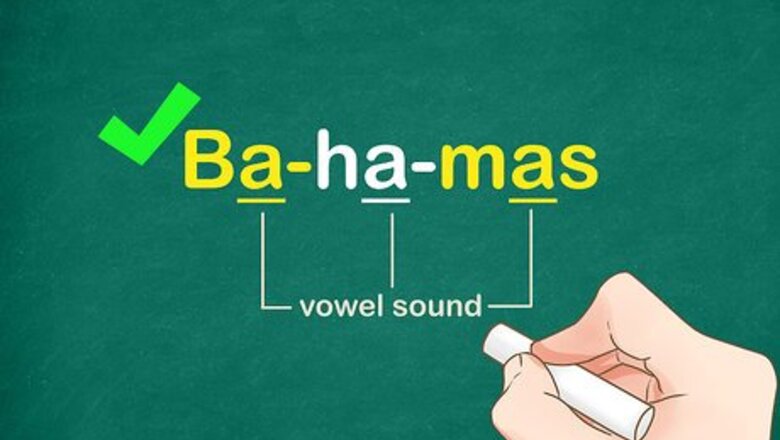
views
Knowing the Rules of Syllabication
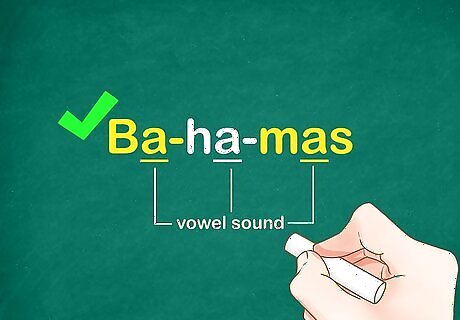
Recognize that a syllable involves a single vowel sound. A syllable is a unit of pronunciation that includes a single vowel sound and that may or may not include the sounds of surrounding consonants. For example, the word Bahamas has three syllables, each with its own vowel sound: "ba," "ha," and "mas." On the other hand, the word flat only has one vowel sound and therefore only one syllable. Remember to ignore silent vowels in this rule, such as the final -e in late. Even though the word late has two vowels, it only has one vowel sound and therefore one syllable. Keep in mind that two vowels next to one another can sometimes be two separate vowel sounds, as in chaos (with its two syllables "cha-" and "-os"). But sometimes two vowels next to one another can make a single vowel sound, as in leaf, which only has one syllable. Time and experience will allow you to determine whether a double vowel makes two vowel sounds or a single vowel sound. There are no syllables that do not involve a vowel sound in English.
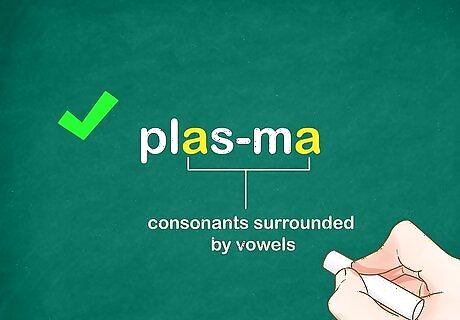
Divide doubled consonants in the middle to make syllables. When you see two consonants in a row that are surrounded by vowels, divide the doubled consonants in half to create proper syllabication. For example, sil-ly, let-ter, mar-ble, plas-ma, and Eas-ter are all the proper way to divide these words into their component parts. The only exceptions to this rule are consonant digraphs, which are single sounds represented by two consonants. Common consonant digraphs include the ph, sh, th, wh, wr, ck, ng, and ch sounds. These should be treated like a single consonant and should not be divided. For example, rather should be divided into rath-er, not rat-her.
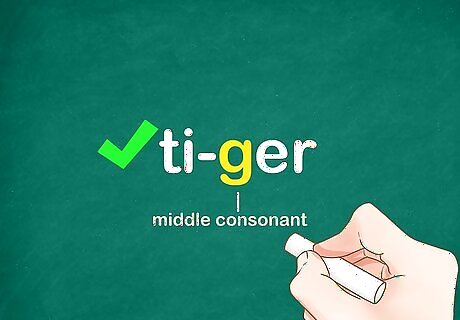
Divide words with single consonants sandwiched between vowels before the consonant. This does not work for all words, but it will work more than half of the time. You should therefore use this method first. For example, if you come across words such as ti-ger, sa-bre, or fi-ber, the syllable division comes before the middle consonant. That initial sound will be a longer vowel sound instead of a shorter vowel sound. Sound out the word to see if this syllable division makes sense.
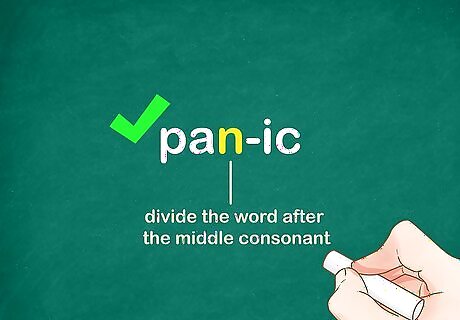
Divide the word after the middle consonant only if dividing before the consonant doesn't sound right. This method works for about 45% of words, so you will use it less often than dividing words before the middle consonant. Use this method only when dividing the word before the consonant does not make a recognizable word. For example, when you come across the word "habit," you should first try dividing before the consonant: ha-bit. However, there is no word that sounds like "hay-bit" in English. You should therefore move on to the second method, which will give you hab-it, a common English word. These words will often begin with a shorter vowel sound instead of a longer vowel sound. Other words in this category include cabin (cab-in), panic (pan-ic), and second (sec-ond). Sometimes, there are differences between American and British English in where you divide the word. For example, Americans would usually divide the word "privacy" as "pri-va-cy" (with a long i sound). However, most British speakers would usually divide the word as "priv-a-cy" (with a short i sound).
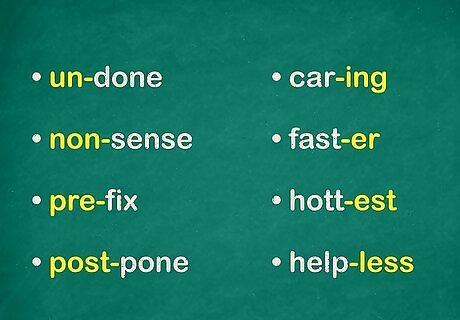
Memorize important English bound morphemes (or units of meaning). A bound morpheme is a part of a word that is unable to stand alone as a word but that has a self-contained meaning. For example, the English prefix non- implies a negation. The English syllable -er implies a comparison. These morphemes usually stand alone as their own syllables during syllabication. If you memorize common English bound morphemes, you will be better equipped to divide words properly. Common bound morphemes include: un-, non-, pre-, post-, -ing, -ed, -er, -est, and -less.
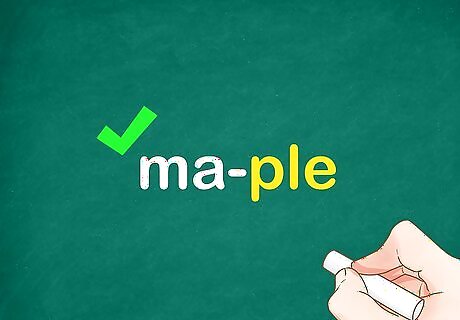
Memorize the special rule about -le words. Words that end in a consonant plus the letters -le have special rules governing syllabication. Divide these words just before the consonant-l-e pattern. For example, bubble can be divided bub-ble; maple can be divided ma-ple; and purple can be divided pur-ple. The exception to this rule is when the -le is preceded by the ck digraph. These words are divided before the -le. For example, pickle should be divided into pick-le; buckle should be divided into buck-le; etc.

Divide compound words in-between the two base words. Compound words are words that are built of two separate, individual words that each carry meaning. For example, driveway, wallpaper, and lampshade are all compound words. Be sure that you divide compound words in between their base components: drive-way; wall-paper; and lamp-shade. If a base word in a compound word is composed of multiple syllables, follow the typical rules of syllabication: wall-pa-per.
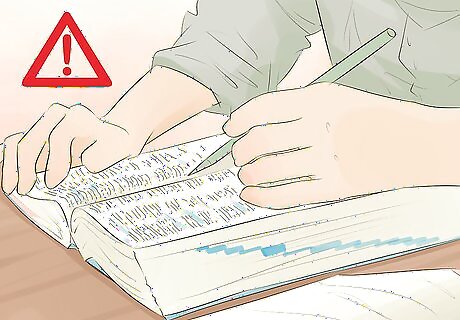
Be wary of dictionaries. Dictionaries usually hyphenate words according to how they should be hyphenated across lines of text. This is distinct from how words should be divided into spoken syllables. Do not rely solely on dictionaries for syllabication support.
Teaching Syllabication to Others
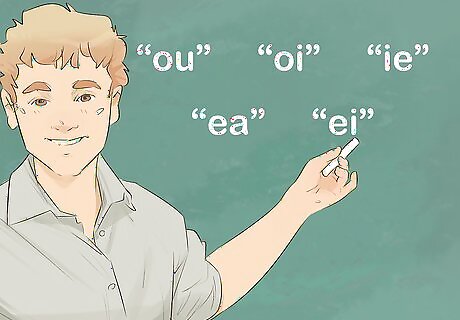
Explain vowel sounds to students. Before a student can learn syllabication, she will have to understand how vowel sounds work. She will also have to learn the fact that some vowel sounds are spelled using two vowel letters, such as the "ou" vowel sound in the word round. Before moving on to syllable division, ask your student to accomplish the following tasks: Know the difference between a short vowel sound and a long vowel sound. Be able to determine a vowel sound for one-syllable words based on the consonants around it. Recognize common English word patterns. For example, they should learn that many consonant-vowel-consonant words involve a short vowel sound, as in rat or tot, whereas many consonant-vowel-consonant-e words involve a long vowel sound, as in rate or tote. Memorize common vowel sounds that are spelled with two vowel letters, such as "ou," "oi," "ie," "ea," and "ei."

Build a student's vocabulary during syllabication instruction. Many of the rules of syllabication are approximations. There are no exact rules that can be applied 100% of the time. Much of correct syllabication has to do with instinct and experience. This is why it is essential that you are helping to build your students' vocabularies and reading skills at the same time that you teach syllabication. For example, continue to ask students to read increasingly difficult texts to expose them to new words, longer words, and new sounds. Assign vocabulary lists to memorize. Make sure you tell students how to pronounce these words as well. Encourage your students to listen carefully to other speakers to hear how words are pronounced and divided into syllables.

Get students used to counting syllables early on. Whether you are teaching young children, new learners of the language, or native speakers, you should introduce the concept of counting syllables as early as possible. Read off several words of varying lengths, and ask your students to identify the number of syllables they hear. They should be comfortable with counting syllables well before they begin syllabication themselves.

Have your student touch his chin while speaking. Ask young students or people who are having trouble understanding syllables to hold his own chin while saying words. In general, the chin will drop each time there is a new syllable. This physical activity will help make the idea of syllables more concrete.

Use drumming and clapping to emphasize syllabication rules. This is especially useful for younger children. Ask your student to clap along with words of varying lengths: one, two, three, and four-syllable words. While clapping might not help your student understand where exactly a word will be divided, this exercise will help your student begin to understand how syllables work, and how many syllables are found in common words.
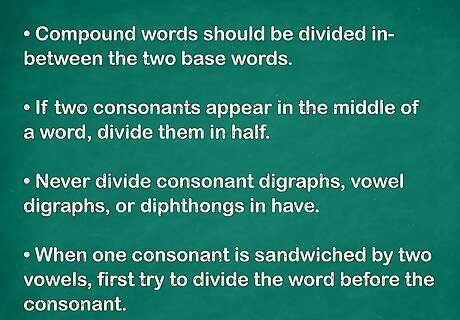
Have your students memorize only the most useful syllabication rules. Practice and application are the most useful ways to teach syllabication. Having students memorize dozens of minor rules will not help them get the experience they need to understand syllabication. Only have them memorize the most useful rules of syllabication: 1) Compound words should be divided in-between the two base words. 2) Bound morphemes often comprise their own separate syllable. 3) If two consonants appear in the middle of a word, divide them in half. 4) But never divide consonant digraphs, vowel digraphs, or diphthongs in have. 5) When one consonant is sandwiched by two vowels, first try to divide the word before the consonant. If that doesn't work, then try to divide the word after the consonant.
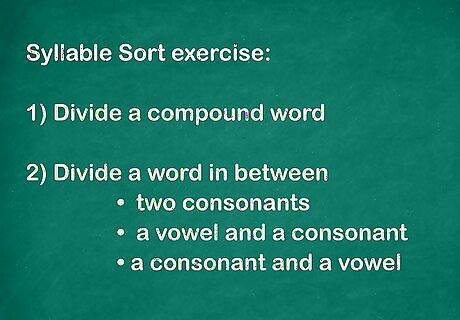
Give students the Syllable Sort exercise. The Syllable Sort exercise asks students to make lists of words that adhere to various rules of syllabication. At the top of a piece of paper, list four major categories of syllabication: 1) Divide a compound word; 2) Divide a word in between two consonants; 3) Divide a word in between a vowel and a consonant; 4) Divide a word in between a consonant and a vowel. Ask students to brainstorm words that might fit each of these categories, and have them divide the word according to the relevant rule.
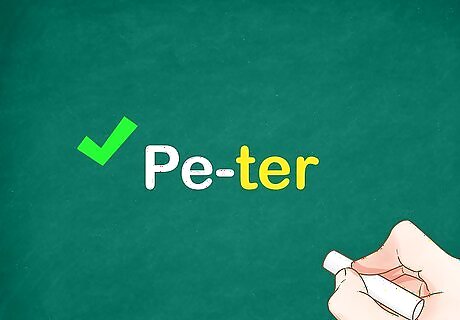
Ask students to divide proper names into syllables. Many students already know how to pronounce the names of their classmates and friends. Use this knowledge as a tool to emphasize syllabication lessons. Have your students divide up each other's names into correct syllables to reinforce your syllabication lessons.

Make a syllabication game using index cards. Write 50 common English syllables on separate index cards. Make sure that these syllables can be combined in various ways to create real English words. Then ask your student to combine these syllables in various ways to create real words and nonsense words. Ask your student where each word should be divided.
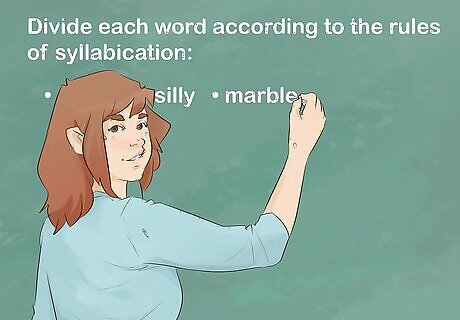
Reinforce syllabication knowledge using quizzes and tests. Give your student a list of words that are two-, three-, and four-syllables long. Ask your student to divide each word according to the rules of syllabication. If you notice that your student does not understand a particular pattern, review the rules once more and re-test.




















Comments
0 comment